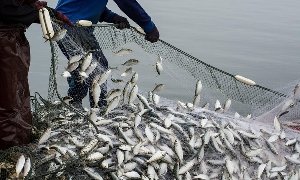A World Economic Forum study has brought to light concerning statistics: in 2021, nearly 23.8 million tonnes (MT) of seafood, equivalent to 14.8 percent of the global production, went to waste, amid escalating worries about food security issues.
Projections indicate that by 2030, the global consumption of aquatic foods will reach a staggering 181 million metric tonnes (MT).
This surge in demand, driven by recognition of the nutritional benefits of seafood, intensifies international apprehensions regarding seafood loss and waste (FLW), prompting calls for concerted mitigation efforts.
Investigations into global aquatic FLW have identified various stages within the aquatic food value chain as culprits.
These include fish discarded at sea, fish processing on land, retail, and food services (encompassing sales and consumption in hotels, restaurants, and catering establishments – HORECA), as well as household consumption.
While the first four stages contribute to food loss, the final stage – household consumption – is classified as food waste.
This category notably arises from consumers purchasing or cooking more than they require and subsequently disposing of unconsumed food.
The United Nations Food and Agriculture Organization (FAO) defines food loss as “food that has unavoidably become unfit for human consumption, leading to a decrease in the quantity or quality of food”. Food waste is defined as “the removal of food that is still fit for human consumption by choice due to spoilage or food expiration”.
The report highlights the primary drivers of aquatic food loss and waste (FLW) along the value chain, revealing that globally, the most significant contributors are processing on land and discards from wild-capture fishing, accounting for 21.55% and 11.79% respectively. In contrast, food service constitutes the lowest percentage at 4.65%.
Furthermore, the analysis indicates that the percentage of total edible loss varies across continents. Asia records the highest at 37%, followed by Europe with 31.81%, while Oceania experiences less than 2% of edible aquatic food loss in 2021. Africa ranks fourth with 10.41%.
Comparative analysis between lower/middle income and higher income nations reveals distinct patterns: in lower/middle income countries, most aquatic FLW occurs during post-harvest and processing, while higher income nations generate large proportions of FLW during consumption. The former’s loss is primarily attributed to poor handling techniques, financial constraints limiting technological advancements, and insufficient cold storage and transportation facilities, while consumer attitudes towards waste play a significant role in higher income countries.
Recognizing the significant magnitude of global aquatic FLW, the analysis suggests several interventions to tackle the issue, including by-product utilization, investment in skills and knowledge, adaptation to market trends and diversification, adoption of emerging technologies, enhancement of infrastructure, industry collaboration, and development of robust policy and regulatory frameworks.
By-product utilization emerges as the most rational approach to reduce aquatic FLW, as aquatic foods by-products serve as valuable raw materials for various purposes, including aquacultural and agricultural feeds, compost, fertilizers, and biofuel. Additionally, they have promising applications in pharmaceuticals, cosmetics, and biodegradable materials.
Furthermore, incorporating cutting-edge technologies like blockchain, artificial intelligence (AI), big data analytics, and 3D printing offers novel potential for more effective assessment and relief of aquatic FLW.
Encouraging collaboration across different scales and stages of the value chain is also recommended, as it promotes a culture of collective responsibility for waste reduction.


